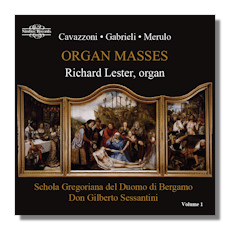
The Internet's Premier Classical Music Source
Related Links
-
Cavazzoni Reviews
A. Gabrieli Reviews
Merulo Reviews
Bertolodo Reviews - Latest Reviews
- More Reviews
-
By Composer
-
Collections
DVD & Blu-ray
Books
Concert Reviews
Articles/Interviews
Software
Audio
Search Amazon
Recommended Links
Site News
 CD Review
CD Review
Organ Masses, Volume 1

- Girolamo Cavazzoni: Missa Apostolorum
- Andrea Gabrieli:
- Missa de Beata Vergine
- Toccata Quinto tono
- Anchor che co'l partire
- Claudio Merulo:
- Missa in Dominicis Diebus
- Toccata del terzo tono
- Sperindio Bertoldo: Communion, Ricercar del sesto tuono
Richard Lester, organ
Schola Gregoriano del Duomo di Bergamo/Don Gilberto Sessantini
Nimbus NI5909/11 3CDs 3:17
We can trace the organ mass (in which choir and organ alternate) to the fourteenth century. By the time of the Council of Trent (1545-1563), which was convoked to standardize the mass, the style was fully integrated and had become an accepted part of the Mass Ordinary. In this highly enjoyable set of three CDs from Nimbus, keyboard specialist in music of the period Richard Lester presents a carefully-chosen program of works by composers writing at the time of the Council of Trent.
The recordings were made in July 2013, in Bergamo's Accademia Musicale Santa Cecilia, where Lester plays the Giovani Pradella organ. Singing with him is the Schola Gregoriano del Duomo di Bergamo, whose director is Don Gilberto Sessantini; they also participated in Volume V of Lester's Frescobaldi series on Nimbus NI5887.
In each of the three major pieces, the masses by Cavazzoni, Andrea Gabrieli and Merulo, which occupy the bulk of the CDs at 50, 58 and 60 minutes respectively, the integration of organ and voices is wholly convincing. There is never a sense of too great a contrast between the two. Indeed, the alternatim style slowly and surely furthers the sense of musical progression throughout each work.
Lester's touch on the organ is as sensitive to the devotional impetus behind Cavazzoni's, Gabrieli's and Merulo's instrumental writing as is the vocal articulation by the Bergamo choir in the choral passages. The matches, parallels and reflections, for instance, in the opening of Merulo's glorious "Missa in Dominicis Diebus" [CD.3 tr.2] are total – and totally integrated. Although the textures of organ and choir are contrasting ones, they are also complementary in ways that reinforce the projection of each mass. Lester's conception and execution here avoid proto-operatic models, and models of the Greek Chorus. Mere "commentary" would have been flat and uninspiring. Instead, Lester and his colleagues have arrived at a convincing amalgam that truly captures the essence of this complex and comprehensive form. They do it full justice and make the organ mass sound wholly natural. Indeed, this alternation intensifies and re-inforces the impact of each.
Of Cavazzoni little is certain. His music is melodious, beautiful and similar in style and scale to that of the two better-known composers represented in this first volume of organ masses, Andrea Gabrieli and Claudio Merulo. Of Sperindio Bertoldo even less is known… only that he died in or around 1572, making him the "youngest" of these three Northern Italian composers.
Lester's highly accomplished playing has the characteristics on the one hand of stateliness, dignity and a measured reserve (most noticeable in tempi and phrasing); and enthusiasm, immediacy and realism on the other. This makes for what one imagines are styles of performance particularly faithful to the way the music must have sounded in the sixteenth century.
There is nothing self-conscious, forced, artificially rhetorical about the way in which Lester coaxes every last nuance from the music of the three supremely self-confident composers. The fact that the organ masses take the (corresponding) plainchant as their starting point accounts in no small part for the minor majesty of this music. Lester also has the gift of playing in such a way that we are drawn forward throughout the performance. We quickly become eager to hear each next movement. This awareness of and quiet adherence to each work's structure also draws us in to the devotional color of the music. It becomes less performance; more of a faithful – and highly successful – incarnation of the musical and confessional strengths of the works of art. Yet without being either overt homage or (covert) recreation. In other words, the music comes to life.
The acoustic is gentle and responsive. The balance between choir and organ is realistic; necessarily, it promotes the organ to be for us the sound which we would have heard if placed nearer to it, perhaps, than the majority of worshippers were. Although the music on the CD is not intended as a recreation, it's a unity. The highly informative essay in the booklet was written by Lester; it also contains details of the instrument and the order of the works played… because these are Masses Ordinary, no texts are really necessary. No other recordings exist of the Cavazzoni and Gabrieli Masses or the Bertoldo Communion. Even were this not the case, the quality of playing, the intelligent, lively and perceptive response to this wonderful selection of music make this a set to be sought out and enjoyed over and over again.
Copyright © 2013, Mark Sealey





















